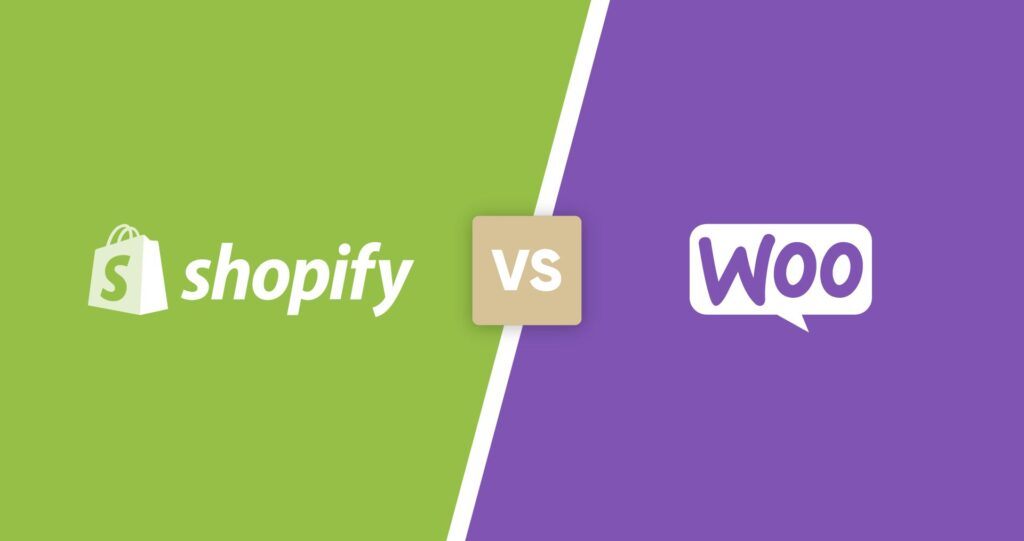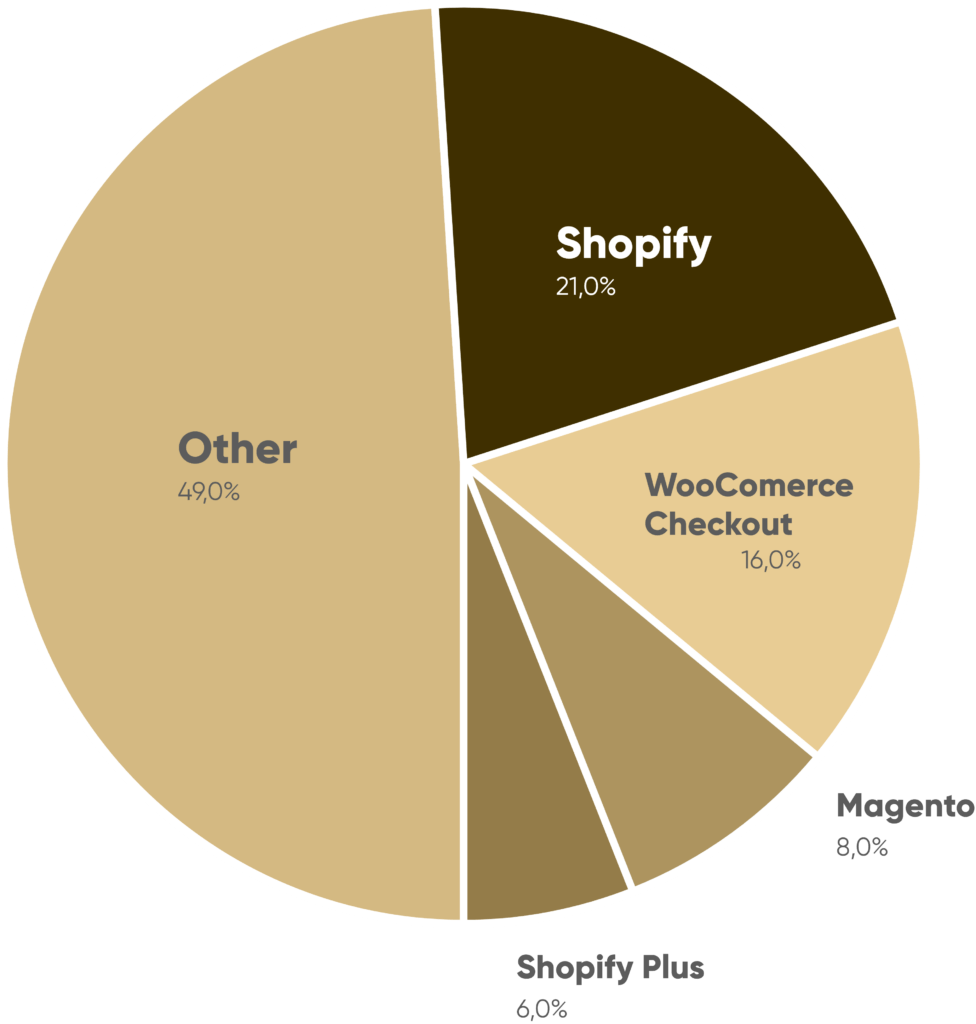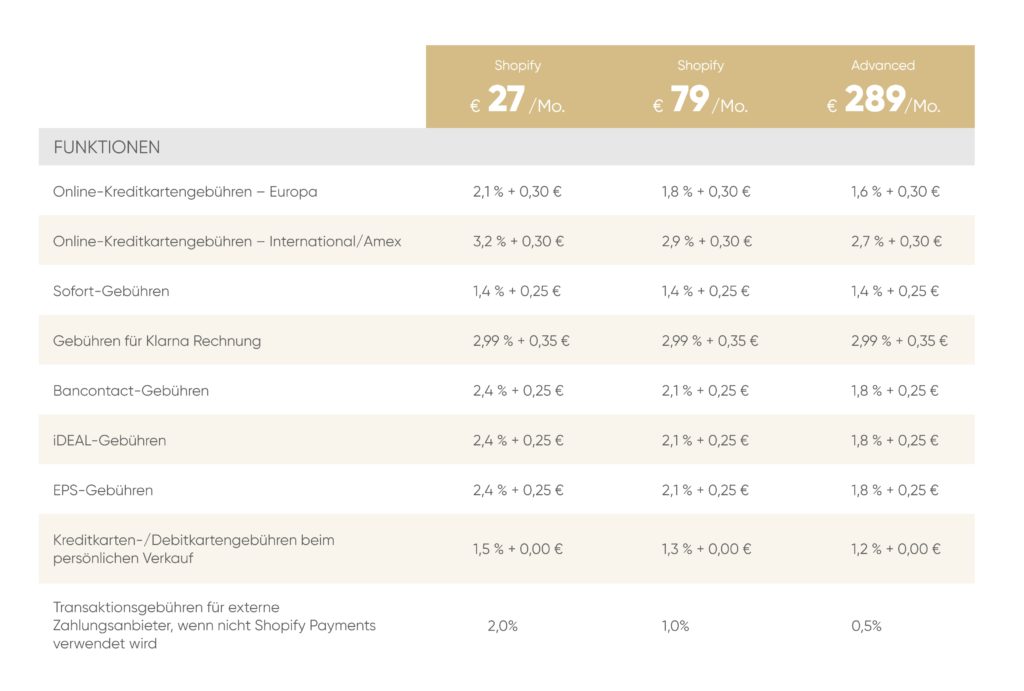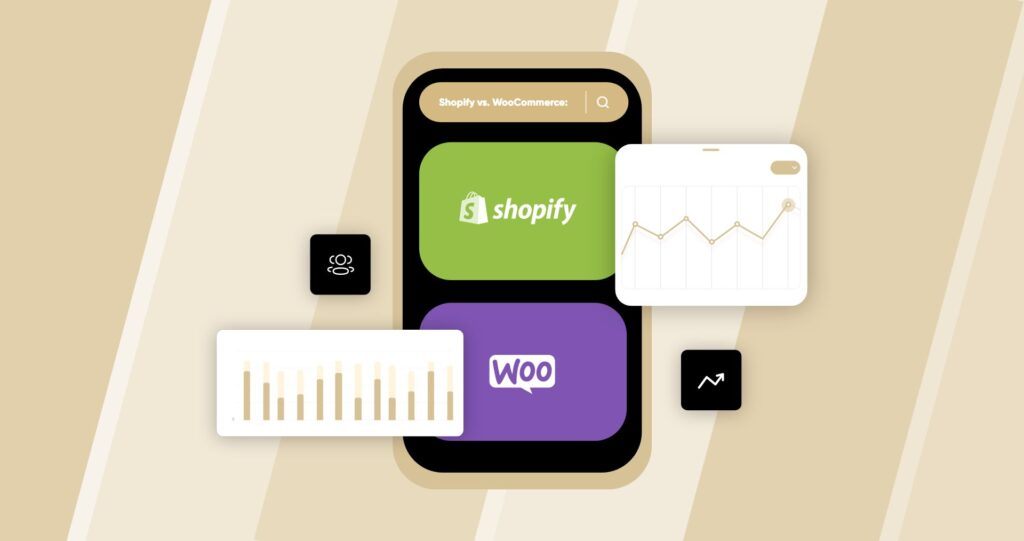Shopify vs WooCommerce: a decision-making aid

At the end of 2023, according to Statista it is clear that e-commerce sales are continuing to grow every year. With sales of 89.4 billion euros, online retail is celebrating new records.
It is therefore not surprising that more and more companies are opting for an online store. This inevitably raises the question of the right e-commerce platform, a decision with far-reaching consequences that should not be taken lightly. Our comparison "Shopify vs WooCommerce" compares the two most popular providers and provides a comprehensive overview of the pros and cons of each platform.
Shopify or WooCommerce, the most important things at a glance
Is our detailed comparison too long for you? Then we have summarized the most important points for you here so that you can quickly decide whether Shopify or WooCommerce is the right platform for you.
Pro Shopify
- Ease of use: Shopify shines with a simple and user-friendly interface, which is particularly advantageous for beginners.
- Hosted solution: Shopify's cloud-based hosting relieves users of the responsibility of server management and enables easier scaling.
- Support: Shopify offers comprehensive customer support via various channels, including live chat and telephone.
- App Store: A wide range of apps and extensions are available in the Shopify App Store to provide the store with additional functions.
- Security: Shopify takes care of security aspects, including automatic SSL certificates.
Contra Shopify
- Costs: The monthly fees and transaction fees with Shopify can add up in the long run, especially with higher sales.
- Customization: Compared to WooCommerce, Shopify's customization options are more limited.
- Ownership: As it is a hosted platform, users have less control over the source code of their store.
Pro WooCommerce
- Flexibility: WooCommerce offers full control over the source code and allows extensive customization, which is an advantage for experienced users and developers.
- Cost: The basic version of WooCommerce is free, and the total cost depends on hosting and optional extensions.
- WordPress integration: Seamless integration with WordPress, particularly beneficial for users who already run a WordPress website.
- Large community: Active developer and user community offers support and a variety of extensions.
- SEO-friendliness: Good customization options for SEO are provided by default.
Contra WooCommerce
- Learning curve: The learning curve can be steeper, especially for beginners with no prior knowledge of WordPress.
- Own hosting required: Users must take care of their own hosting, which may require technical expertise.
- Security responsibility: As a self-hosted solution, responsibility for security lies with the user.
Shopify vs WooCommerce: Which is which?
Before we get started and I show you the strengths and weaknesses of Shopify and WooCommerce, I would first like to briefly introduce you to both.
Shopify was founded in 2006 by Tobias Lütke, Daniel Weinand and Scott Lake. The idea was born when Lütke tried to create an online store for his snowboard products but was dissatisfied with the existing platforms. In order to maintain control over his shopping experience, he began developing his own platform. This effort led to the creation of Shopify, an e-commerce solution that quickly gained popularity and became one of the leading platforms for online commerce. Shopify is characterized by its ease of use, flexibility and comprehensive features that allow merchants to effectively manage and grow their online presence.
WooCommerce, on the other hand, is an e-commerce solution that was developed as a WordPress plugin. The story of WooCommerce began in 2011 when the developers of WooThemes realized that there was a lack of robust, user-friendly e-commerce integration for WordPress. In response, WooCommerce was launched to seamlessly transform WordPress websites into fully functional online stores. The platform has quickly become one of the most popular solutions for businesses looking to sell their products online. With a variety of extensions, a strong developer community and the integration of WordPress as a base, WooCommerce offers a flexible and customizable solution for online retailers.

The latest data from Builtwith underpins the dominance of Shopify and WooCommerce. They analyzed the top 1 million online stores and came to the conclusion that Shopify operates 21% and WooCommerce 16% of all e-commerce stores. With Shopify Plus the Canadians are represented with another 6%, this offer is primarily aimed at large companies.
Compared to historical data, Shopify has displaced WooCommerce from the top spot and is now the top provider, but depending on your requirements, WooCommerce may still be the better choice. That's why we want to offer you a comprehensive comparison based on 10 criteria.
#1 Ease of use: How easy is it to open a store on the respective platform?
User-friendliness is an issue that should not be underestimated. Shopify clearly has the edge here, which is logical, as this was not least the decisive factor in bringing the e-commerce solution to life. Creating a store in Shopify is kept very simple and can be implemented quickly, even by newcomers.
Since WooCommerce is a WordPress plugin, the first step is to set up the WordPress CMS, which can be a little more complicated and requires some know-how.
Our assessment
While Shopify already offers almost all the necessary features in one package, WooCommerce can be seen more as a modular system in which the user can assemble all the required components in the WordPress space. This is not necessarily a disadvantage, but WooCommerce definitely has a steeper learning curve than Shopify.
#2 Hosting: What are the differences?
One of the most significant differences between Shopify vs WooCommerce is the hosting. While Shopify takes care of the hosting for you, with WooCommerce you have to set up your own hosting.
Shopify's hosting is cloud-based and included in the monthly costs. This approach is more relaxed and can be scaled more easily. Thanks to the automatic rules in the background, you don't notice anything and have one less construction site to worry about.
WooCommerce is self-hosted, which means that you have to take care of the hosting yourself when setting up the online store; you can either set up your own server or choose the server of a third-party provider.
Our assessment
Shopify wins here too. Self-hosting can be complicated and confusing, especially for newcomers to online retail. Although the independent choice of server also has its advantages, the cloud solution is the clear winner in terms of convenience.
#3 Price and costs: Shopify vs WooCommerce
Of course, costs also play a role in running an online store. However, these are difficult to compare. Shopify offers a complete solution, while WooCommerce and WordPress are initially free open source platforms.
WooCommerce can therefore initially be operated completely free of charge and only requires hosting, which costs 10 - 15 euros for a medium-sized online store, and a domain. There are also fees depending on the payment provider.
The Shopify costs are calculated from a monthly payment and fees per sale. The monthly costs amount to:
- Basic 36€
- Shopify 105€
- Advanced 384€
There is a 25% discount for annual payment, you can find an overview here:

To keep your store competitive, you will also need additional themes, plugins and apps. There is a large selection of free and paid versions.
Our assessment
This is where WooCommerce shines with its open source approach, which in theory makes it extremely cheap to get started, although this requires some programming knowledge. In general, WooCommerce costs are more variable, while Shopify is relatively transparent about what the costs amount to.
#4 Flexibility and features: How much control do you have over your store?
Although Shopify is one of the more flexible hosted solutions, WooCommerce clearly has the advantage of flexibility thanks to self-hosting. WooCommerce already offers you a solid basic framework for your store, all other solutions can theoretically be built yourself without restrictions (programming knowledge required), but for 99% of the problems there is already a plugin that can be integrated effortlessly. Often even free of charge. In the Woo Marketplace you will find numerous plugins especially for WooCommerce.

Shopify has launched the Shopify App Store also has various options for expanding your store, but the selection here is limited. In addition, there are some areas that cannot be easily customized. The situation is similar when it comes to design. While there are hardly any limits in WordPress, Shopify always has a similar structure.

Our assessment
WooCommerce leaves nothing to be desired in terms of features and has the upper hand here. In contrast to Shopify, there are virtually no restrictions here.
#5 Scalability: Are there limits to growth?
A fast-growing company needs an infrastructure that can easily scale with it. As the operator of an e-commerce company, you don't want your own store to become a bottleneck.
The good news is that both Shopify and WooCommerce are scalable. But the conditions are different. With cloud hosting, Shopify adjusts the capacity of your store to ensure scalability at all times.
With WooCommerce, the right choice of server plays an important role. If it is not prepared for high traffic volumes, this can lead to problems. This can be particularly problematic during promotions such as Black Friday or other events. With harmonious growth, the server can simply be increased in the future.
Our assessment
In terms of scaling, Shopify offers the simpler solution that can also handle traffic spikes. WooCommerce users must always keep an eye on the server load and are actively involved here.
#6 Performance: How fast and stable is the store?
In recent years, the demands placed on online stores have continued to rise. Fast loading times are an extremely important factor for a good user experience and are expected as standard. If stability is not achieved and the store takes too long to load, the bounce rate increases rapidly.
Here too, the comparison between Shopify and WooCommerce is not clear-cut. The speed of WooCommerce again depends on the hosting provider, here it is very important to choose the right package to minimize delays. This can quickly add up. WooCommerce itself is a little sluggish by nature, a cache plugin is indispensable here, with which HTML, CSS and JavaScript code can be compressed, which is essential.
Shopify already has these features and is therefore once again less complex. There is also a selection of themes specially optimized for loading speed. Please read our Shopify Themes guide.
An important point for both platforms is the use of apps/plugins. Although the selection is large and many useful features can be added, this is often at the expense of speed. It is therefore advisable to keep the store system as lean as possible.
When it comes to stability, Shopify is one step ahead. The cloud-based hosting means that updates are installed automatically. With WooCommerce, updates have to be installed manually, so more maintenance is required. Skipping updates can lead to security vulnerabilities, so all new updates should be installed as soon as possible.
Our assessment
Shopify once again impresses with its cloud hosting. The administrative effort is lower and handling is easier. WordPress can work at least as well as ever, but more effort is required.
#7 Payment methods: Who has the better gateways?
When it comes to accepting payments, there is exactly one rule: the more, the better. If customers cannot find their preferred payment method when shopping online, it is possible that they will not complete the purchase of their desired item.
By supporting more payment methods, you increase the attractiveness of your store. The good news is that both Shopify and WooCommerce have multiple payment systems.
WooCommerce supports all common payment methods, including PayPal, Stripe, Square and even regional providers. However, a plugin is required for many of the gateways, with some incurring additional costs. By default, only direct bank transfer, check payment, cash on delivery and PayPal are integrated.
Shopify has its own payment system, Shopify Payments, which requires no further configuration and comes without extra fees. Although Shopify also supports other gateways, it charges additional fees for their use. Depending on the Shopify plan, the fees amount to 2%, 1% or 0.5%.
Our assessment
Shopify penalizes customers who do not want to use their own payment gateway, while WooCommerce focuses on more freedom again. On the other hand, Shopify is ready to go immediately when using Shopify Payments, while WooCommerce requires further configuration.
#8 GDPR compliance: Are the platforms legally compliant?
The GDPR (General Data Protection Regulation) has been designed to protect users on the internet since 2018. It is intended to guarantee privacy and security. For website operators, this primarily means a lot of effort and costs that could threaten their existence if they fail to comply with the guidelines.
Shopify is aware of the GDPR in Europe and offers a legally compliant theme that has even been certified by the Händlerbund in Germany. In addition, every Shopify store comes with an SSL certificate and is also PCI DSS-compliant at the highest level. This means that customers surf the site with the highest security standard and credit card transactions also take place in a secure environment. Shopify also takes care of the latest updates automatically.
WooCommerce, on the other hand, was not designed for the European region and must therefore be set up by the operator in compliance with the GDPR. All reputable hosting providers provide SSL certificates as standard, and there are plugins that can help with everything else. However, achieving GDPR compliance for your WooCommerce store can incur additional costs.
Our assessment
The fact that Shopify is already GDPR-compliant out of the box must be seen as a clear advantage. This can avoid many headaches. A legally compliant cookie banner should also not be missing in your online store, here you can find our guide to the Shopify cookie banner
#9 SEO friendliness: Can the store be found in search engines?
Only those who can be found on the Internet can also sell their products. Search engine optimization plays a particularly important role here, as a large proportion of e-commerce sales come from organic traffic.
The WooCommerce code is already SEO optimized and meta descriptions, titles and URLs of your product pages can be adjusted. The basics are therefore already provided by WooCommerce.
There are also helpful plugins that make search engine optimization easier for you. Very popular here is Yoast SEOwhich even beginners can use to get started, as the plugin provides recommendations for many SEO-relevant practices.
Shopify also gives you the opportunity to implement basic SEO practices, and there are also plugins here that offer advanced functions. With the app SearchPie app, for example, your entire store can be scanned and you can make improvements based on the report.
Our assessment
Both platforms are SEO-friendly, WooCommerce again offers full flexibility here, but top rankings for relevant search terms can also be achieved with Shopify. Like all marketing measures, search engine optimization should be left to the experts. Mistakes are often made at the beginning due to a lack of knowledge, which damages visibility on the web, and the choice of platform plays a subordinate role.
Whether WooCommerce or Shopify SEO. We are happy to support you and can offer you everything from an initial consultation on search engine optimization to setting up a solid basic framework and full support for your store.
#10 Support and community: Where can you get help?
Although Shopify is easy and intuitive to use, it probably won't work completely without help. To enable everyone to get started in online retail, the Canadian company has a range of possible assistance.
First and foremost, the platform has a help center with articles, tutorials and instructions. For people who prefer videos, Shopify operates a YouTube channel and hosts regular webinars.
If you're fluent in English and want to learn all the Shopify basics from scratch, the Shopify Academy is the best place to start. Here you will find free courses that can expand your knowledge.
If you can't solve a problem on your own, you can also get help here. In the official Shopify forum you can exchange ideas with other users and ask questions about problems. You can also contact the Shopify support team by email, live chat or phone, 24 hours a day.
WooCommerce also has some self-help resources on offer. The official documentation offers a large amount of helpful instructions for successfully running a store with WooCommerce. However, this is in English. Also the WooCommerce blog is full of added value and good advice.
Last but not least, it once again depends on the choice of a competent hosting provider. With an online store, downtime or poor performance is often devastating, so 24/7 support is of great importance here.
Our assessment
Shopify attaches great importance to providing its users with all the knowledge they need. Support is also included in the price. WooCommerce also has many useful resources, but here the community comes more to the fore. Support here depends on the hosting provider and their expertise.

Conclusion Shopify vs WooCommerce, who is the winner?
In conclusion, there is no clear winner. Whether Shopify or WooCommerce suits your business better depends on your requirements and preferences.
The fundamental differences are obvious. Shopify shines with its user-friendliness and focus on the essentials. WooCommerce, on the other hand, offers complete creative freedom with its open source approach and focuses on personal responsibility.
Together, the two platforms account for 43% of the top 1 million online stores. Both are therefore extremely popular and both will continue to support numerous retailers in operating an online store in the coming years.
Frequently asked questions about the Shopify vs WooCommerce comparison
Which is better: Shopify or WooCommerce?
That depends on your individual needs. Shopify is ideal for users who are looking for an easy-to-use, hosted solution without technical complexity. WooCommerce, as a WordPress plugin, offers more customization options, but is more complex to use.
Who is WooCommerce suitable for?
WooCommerce is particularly suitable for users who already run a WordPress website and want full control over their online store. It is ideal for those who value technical flexibility and customization options.
When does Shopify make sense?
Shopify is useful for users who are looking for a fast and uncomplicated e-commerce solution without having to worry about technical details such as hosting. It is particularly suitable for smaller companies or retailers who value user-friendliness.
How much does a WooCommerce store cost?
The costs for a WooCommerce store vary depending on the individual requirements. The basic version of WooCommerce is free, but there are costs for domain, hosting and possibly premium themes or extensions. The total costs depend on the desired functions and the hosting provider.






